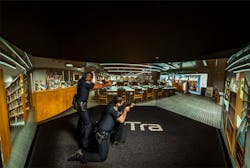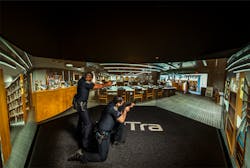The Value Of Virtual Simulation Training For Active Shooter Response
The three-man team made its way down the hallway walking fast, but not running. The point man was armed with an H&K MP5. He had it shouldered and was searching forward over the weapon sights, the gun tracking with his eyes like a tank turret following a weaponeer’s visual targeting system. The flank officers were armed with handguns, each calling out information about doorways and hallways as they were approached and passed. Shots were heard down the hallway in front of the team and they picked up their pace. Shouting could be heard as well; screams that were a mix of incoherence and clear communications. “No, Johnny!” “Don’t do that!” “Put that down!” As the team approached the doorway they could hear sounds of a struggle, what sounded like a fist on flesh, harsh words and then relative silence. They rounded the corner, weapons still up and seeking targets. The point man sees an adult. He has a student, holding him by the front of his shirt in his left hand.
In his right hand is a handgun, pointed in the student’s face. The teacher looks up and sees the team just as they round the corner. Before the team can take any action the teacher puts the handgun down on the nearest counter top. It is only then that the point man realizes they are in a chemistry lab. There are no desks, but countertops with sinks, faucets and gas jets. He hears the teacher, now raising both hands in the face of three weapons all aimed in his direction, “It’s not mine! I took it from him!” The point man sees the student looking over at them…and then at the gun. The gun is still within his reach…and he begins to reach for it.
The point man screams out, “Don’t touch it!” just as the student’s hand reaches the handgun’s pistol grip. Almost hating himself for it, the point man pulls the trigger on his MP5. The subgun’s selector level is set on burst and three rounds stitch the student from solar plexus to left clavicle. The student’s hand falls away from the handgun as the teacher staggers away from the shots, small splatters of blood hitting his shirt and face. As the student begins to fall the whole scene freezes. The three-man team holds their position and waits for further instructions. After another few seconds they hear the simulation instructor’s voice, “Stand down. End of scenario. Safe your weapons and report to the conference room for debriefing.”
This is one example of how a simulation was used to train response for an active shooter event. The recounting is of a true training event. The simulator used was of an unspecified manufacturer and the software controlling the simulation was an early generation of such. It was developed to test a limited set of behaviors and really only one decision—to shoot or not shoot the student reaching for the handgun. While those were the limitations at the time, projected simulation training has come a long way. There are some limitations to using virtual simulation training, but there are also some great benefits to it as well.
Limitations to the training
Movement: Due to the fact that the projected simulation has to be set onto a screen that is immobile, any officers going through such training are restricted in their movement. How to move through a high-risk environment complicated by obstacles, noise, vision limitations and more is usually a large part of any active shooter response training. Such can still be trained in a weapons-dry and safe environment.
Equipment cost: Purchasing a projected simulation system isn’t a small item to put in an agency budget. In addition to the original purchase price, there is a cost attached to training instructors for using the system as well as the space to be dedicated for it. Many agencies get around this challenge by combining resources and sharing virtual simulation systems.
Settings and circumstances: One of the things that officers must keep in mind as they move through projected simulation scenarios is that their surroundings are vastly different from what they would be in a real situation. In a real situation there would be items to be used for cover and, potentially, incoming rounds. There could be obstacles such as discarded backpacks, bodies, injured students and other items. The environment in a real situation could potentially be full of smoke, water from fire sprinkler systems, screams, alarms and other distractions.
Recognizing the fact that response may have to be performed under such conditions, training under them, or as close to them as possible, is optimal. With a projected simulation training system, any such distractions and conditions would have to be projected or recreated using other equipment.
Valuable benefits
The two largest benefits are safety and depth of adaptive judgment training available with today’s systems.
Safety: Typically, to train active shooter response that incorporates shoot/don’t shoot judgment evaluations, force-on-force equipment is required. That means the agency has to have purchased or have available simunitions-equipped weapons, paintball weapons, Airsoft weapons or other such devices. The use of such training weapons and/or munitions requires even more instructors to be trained and on hand for the training than does a projected simulation system. Additionally, to protect from injury, using force-on-force training equipment also requires the officers being trained to wear protective equipment to protect their face, throat and groin. All of that detracts from the realism of the training and has always been considered an acceptable trade-off for the value of the training and performance evaluations gained.
Unless your projected simulation system has a “shoot back” system included (a system that shoots Airsoft BBs or paintballs at your trainees), then all that safety equipment can be done away with. The weapons typically used for projected simulation training are identical to, or very closely mimic, regular duty weapons. That matters when there’s a concern about mechanical weapon manipulation under stress or limited time allotments.
Depth of adaptive judgement: In addition to the potential safety benefits, there is now the benefit of being able to test multiple behavioral objectives and several layers of judgment. Where “in the old days” a projected simulation might only test one decision—shoot/don’t shoot—now the simulations are multi-branch for decision making. In other words, the instructor can modify and change the direction of the scenario based on the decisions of the trainees as demonstrated by their actions and verbal interaction. If developed and administered properly, the simulation can be set up so that the officer(s) being tested is prompted to demonstrate proper use of cover or certain search techniques. Weapon manipulation and safe handling can be observed and tested as well. Does the rear guard index any of his teammates? If so, it can be observed, recorded for after-action review playback and critiqued/corrected.
If the team is very clear in their verbal commands, the instructor may choose to have the target be compliant, disarm and assume an appropriate posture.
In the scenario described earlier, the features available in today’s virtual simulators allow the operator to manipulate the scene depending on the officers’ commands and actions. The operator could have had the teacher drop the weapon and then have the student reach for it or not reach for it dependent on the clarity of the officers’ commands. Or, as an option, the teacher could reach for it in response to something taunting the student says, thereby putting the officers in the position of having to engage the teacher as the threat. The whole scenario could end with the room door being slammed and transitioning to a barricade situation, thereby prompting an entirely different set of behavioral and performance objectives from the responding team.
With today’s fluid and dynamic response realities where officers have to be trained both for single officer response and team response in team sizes ranging from a pair of officers to four or more officers, projected simulation training can be of great value. That said, the cost of it can be significant for smaller agencies, almost to the point of being prohibitive.
Some agencies seek out nearby allied agencies to either join in a mutually beneficial investment for such equipment or to share training facilities for combined training efforts. The cost of such equipment and the related costs for training instructors, training hours, added manpower costs for patrol coverage are all easier to manage if shared with allied agencies.
Yet, investing in a projected simulation training system and training a few instructors appropriately is more than worth budgeting. Your officers may be called to respond to an active shooter scenario at a workplace, a school or public venue—training with a virtual simulator can be part of that response preparation.
About the Author
Lt. Frank Borelli (ret), Editorial Director
Editorial Director
Lt. Frank Borelli is the Editorial Director for the Officer Media Group. Frank brings 20+ years of writing and editing experience in addition to 40 years of law enforcement operations, administration and training experience to the team.
Frank has had numerous books published which are available on Amazon.com, BarnesAndNoble.com, and other major retail outlets.
If you have any comments or questions, you can contact him via email at [email protected].


